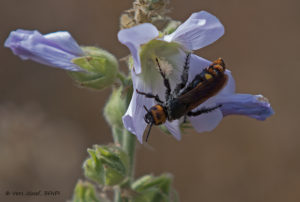Species and habitat description
The Mammoth Wasp with a body length up to 50 mm is the largest European hymenoptera. Females are more abundant in males which body length is less than 20 mm.
The Mammoth Wasp is a solitary living parasitoid species. It is the parasite of the larvae of Scarabaeoidea, the primary host species is the rhinoceros beetle (Oryctes nasicornis), but it can also develop in different species of beetles, for example Polyphylla fullo, the eastern cheafer (Anoxia orientalis), the stag beetle (Lucanus cervus) and the Pentodon idiota. The female dig a hole into the soil to the larvae of the host species with spike legs. She pricks her sting into a larvae causing permanent paralysis and putting an egg on the larvae.
At first, the wasp larvae consume the beetle-larva from the outside but later drill themselves into. After consuming it completely, the wasp-larvae weave a reddish cocoon and overwinter in this form. The adult wasps come out only next spring from the soil. The wasps visit flowers to consume nectar. They are not selective so they can be visible on different plants rich in nectar (Field Eryngo, White Horehound, Dwarf Elderberry, etc.).
The Mammoth Wasp is living in all parts of Hungary, especially in dry, warm places. It is particularly frequent on decayed logs, traces of cut trees remaining in the ground where their host species develop.
Major threats
The Mammoth Wasp is threatened by degradation of habitats, changes in species composition. They are often considered a “dangerous” wasp and are destroyed. It is very important the presence of a structure-diverse forest and the presence of dead wood, too.
Specific conservation action
Improving the structure of homogeneous forest stands, helping mixed species, protecting shrub levels.

Related project areas
Tihany
Bibliography
https://www.dunaipoly.hu/hu/hir/torosdarazsak-es-poszmehek-terjedoben, Vas Zoltán és Merkl Ottó